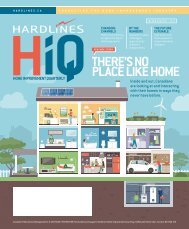HHIQ_1Q_18_complete
You also want an ePaper? Increase the reach of your titles
YUMPU automatically turns print PDFs into web optimized ePapers that Google loves.
MARKET REPORT<br />
F LE<br />
DEALERS FACE<br />
WIDE RANGE OF<br />
CHALLENGES,<br />
OPPORTUNITIES<br />
GOING INTO 20<strong>18</strong><br />
YT<br />
0.2%<br />
BC<br />
11.9%<br />
NT<br />
0.2%<br />
AB<br />
12.4%<br />
SK<br />
4.7%<br />
Canada’s retail home improvement market grew<br />
at a modest but healthy pace in 2016 thanks to Canada’s<br />
red-hot housing market, low interest rates, and ageing housing<br />
stock—all factors driving renovation sales. And that modest growth by and<br />
large maintained itself in 2017. But will the momentum continue into 20<strong>18</strong>?<br />
MB<br />
4.1%<br />
NU<br />
0.2%<br />
ON<br />
34.1%<br />
QC<br />
21.4%<br />
NB<br />
3.5%<br />
NL<br />
3.0%<br />
NS<br />
3.8%<br />
PE<br />
0.6%<br />
I<br />
n 2016, the Canadian retail home<br />
improvement market grew by<br />
barely three percent, while 2017<br />
has proven to be steady, if not exceptional,<br />
for most regions. A few exceptions persist:<br />
the Greater Toronto Area of Southwestern<br />
Ontario has seen healthy growth over<br />
the past two years, and despite changes<br />
last summer to real estate laws in British<br />
Columbia, that province’s Lower Mainland<br />
also remains strong. As a result, the<br />
industry is forecast to grow by a slightly<br />
higher rate in 2017 of 3.5 percent. Sales<br />
growth for the industry over the year<br />
ahead is expected to remain at or slightly<br />
below that level.<br />
HOW DID THE INDUSTRY<br />
MANAGE IN 2017?<br />
Dealers are varied in their response to<br />
business conditions across the country, but<br />
the overall mood appears tentative. Flat to<br />
positive growth is being reported in some<br />
parts of the Maritimes, particularly Nova<br />
Scotia, while Newfoundland and Labrador<br />
is experiencing a slump. Ontario is a<br />
mixed bag: many dealers are flat or down<br />
over last year, with the exception being in<br />
the Greater Toronto Area.<br />
In the West, Alberta dealers report some<br />
growth and an expectation to be up, or<br />
at least flat, over last year, suggesting that<br />
market has indeed “bottomed out” finally.<br />
British Columbia is the only consistently<br />
positive story here, with dealers in that<br />
province expecting to see positive sales<br />
growth by year’s end.<br />
STORE FORMATS DUKE IT OUT<br />
Big boxes continue to be the biggest threat<br />
to independent dealers, thanks both to<br />
strong incremental gains by Home Depot<br />
Canada and to new stores being built<br />
by Lowe’s Canada. In addition, Lowe’s<br />
remains committed to converting its<br />
RONA Home and Garden big boxes to the<br />
Lowe’s banner.<br />
However, buying groups and co-ops<br />
continue to represent the lion’s share of<br />
the industry, both in terms of sales volume<br />
Home Improvement Industry Sales Growth Year over Year ($millions)<br />
2014 2015 2016 2017 (fc) 20<strong>18</strong> (fc)<br />
$43.764 $44.620 $45.949 $47.535 $49.050<br />
3.7% 2.0% 3.0% 3.5% 3.2%<br />
and number of stores. Most independents<br />
are grouped within LBM buying groups<br />
such as Independent Lumber Dealers Cooperative,<br />
with collective retail sales by<br />
its members of $3.8 billion, and TIMBER<br />
MART and Castle, with estimated sales of<br />
$2.8 billion and $2 billion, respectively.<br />
The co-ops, Federated Co-operatives Ltd.<br />
in Saskatoon, Montreal-based La Coop<br />
fédérée, and UFA in Calgary, maintain a<br />
powerful presence, as well.<br />
Hardware stores as a sector continued<br />
to see their sales collectively shrink in<br />
2016, but only by 0.4 percent. The decline<br />
is due mainly to efforts by the likes of both<br />
Home Hardware and Lowe’s, through its<br />
RONA division, to support their dealers<br />
to expand from hardware stores into fullline<br />
building centres, with the addition of<br />
LBM. This format remains viable, however,<br />
and sales overall are slipping as store<br />
numbers fail to grow at the rate of other<br />
retail formats in the home improvement<br />
sector. But expansion of the Ace banner<br />
in Canada, under license to Lowe’s Canada,<br />
has been focused on smaller dealers<br />
and is expected to help hardware stores<br />
keep viable. Ace Canada now has about<br />
80 stores, most of them traditional hardware<br />
stores and some with building materials,<br />
as well.<br />
10 FIRST QUARTER / 20<strong>18</strong><br />
Hardlines Home Improvement Quarterly<br />
www.hardlines.ca
















